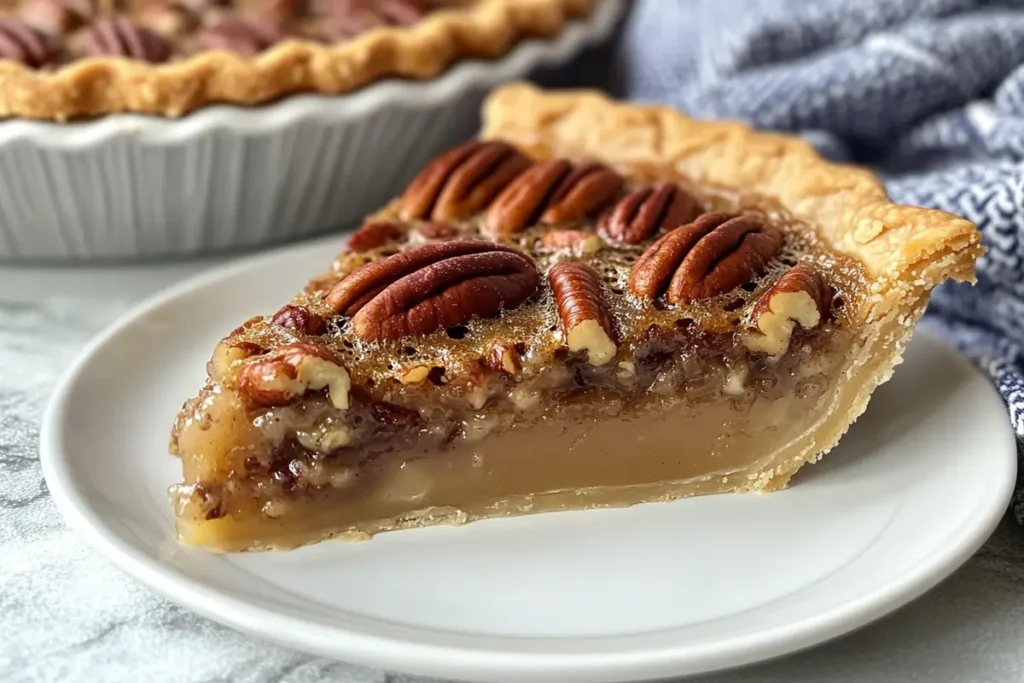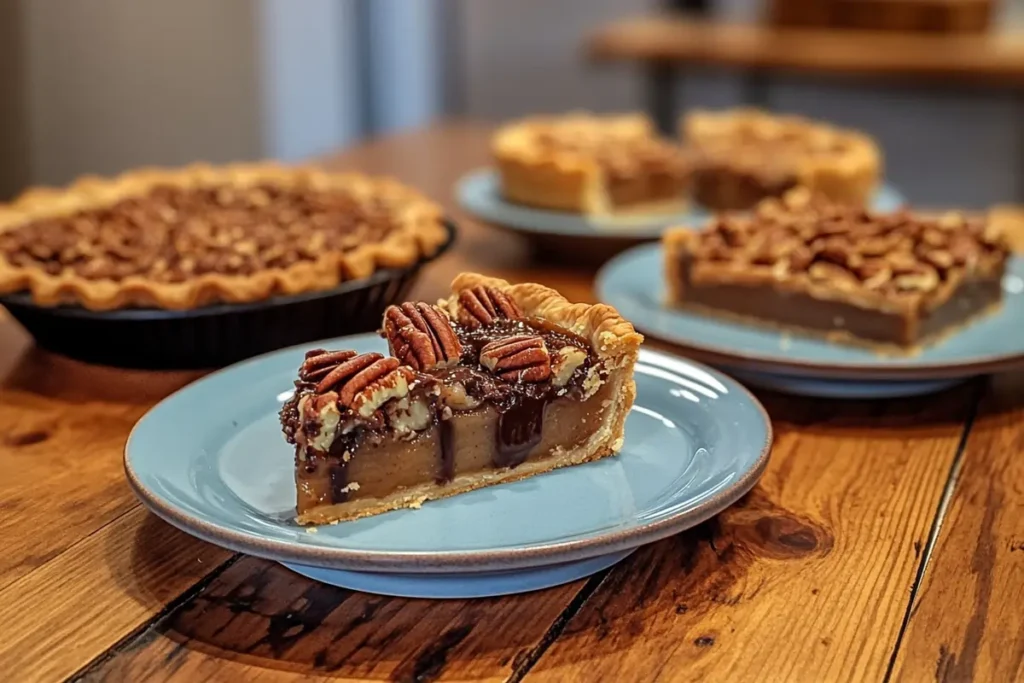Who invented pecan pie? This tantalizing question has puzzled culinary historians for decades. With its buttery pecans and sweet, gooey filling, pecan pie is a dessert beloved by many, especially in the United States. A staple of holiday dinners and Southern gatherings, this iconic treat is as much a part of American culture as apple pie or pumpkin pie.
Despite its widespread popularity, the exact origins of pecan pie remain shrouded in mystery. By exploring its indigenous roots, Southern influences, and modern adaptations, we can uncover the intriguing story behind one of America’s most celebrated desserts—and attempt to answer the timeless question: Who invented pecan pie?
“When uncovering the origins of pecan pie, it’s helpful to consider how its rich flavors and buttery crust have influenced modern recipes, like the decadent Caramel Pecan Cheesecake Pie, which blends pecans with cheesecake for a creative twist.”
Table of Contents
1. The Origins of Pecans
To understand who invented pecan pie?, we first need to explore the nut that forms its foundation: the pecan. Native to North America, pecans were a vital resource for indigenous groups for thousands of years. These nuts, known for their nutritional value and long shelf life, were a dietary staple and often used in ceremonies and trade.
Pecans and Indigenous Communities
- Pecans were consumed raw, roasted, or ground into pastes.
- The term “pecan” derives from an Algonquin word, meaning “nuts requiring a stone to crack.”
- Indigenous groups taught European settlers how to harvest and prepare pecans, laying the groundwork for their eventual incorporation into desserts.
While these communities didn’t bake pecan pies as we know them today, their appreciation for the nut undoubtedly influenced later culinary developments.
1.1 Early Mentions of Pecan Pie
So, who invented pecan pie? Early documented recipes suggest that the dish evolved from custard pies, a dessert brought to America by European settlers. These pies combined eggs, sugar, and milk to create a smooth filling and were adapted over time to include regional ingredients like pecans.

Milestones in Pecan Pie’s Development
- 1886: Harper’s Bazaar
The first recipe resembling pecan pie appeared in Harper’s Bazaar. While referred to as a “pecan custard pie,” it included many of the key elements found in today’s pecan pie. - 1898: St. Louis Cookbook
Another significant recipe, credited to a Texas woman, was published in a St. Louis cookbook. This highlights pecan pie’s Southern roots and its evolution as a regional specialty. - French Influence
Some theories suggest that French settlers in Louisiana, inspired by indigenous pecans, adapted their tarte aux noix recipes to include the nut. This fusion of cultures may have been an early step toward the modern pecan pie.
These recipes provide clues, but the exact inventor of pecan pie remains elusive.
While the history of pecan pie is tied to the American South, its influence can also be seen in recipes like No-Bake Pecan Pie Cheesecake, which offers a simpler, more modern take on the classic dessert.
1.2. French Influence on Pecan Pie
Another piece of the puzzle in answering who invented pecan pie? lies with French settlers in Louisiana. Upon encountering pecans through indigenous communities, these settlers likely incorporated the nut into their desserts, drawing inspiration from their nut tarts and custard pies.
How French Settlers Contributed
- Custard bases: French techniques influenced the smooth texture of pecan pie filling.
- Pastry innovations: Their skills in creating flaky, buttery crusts became part of the dish.
- Cultural fusion: Combining indigenous ingredients like pecans with European baking traditions.
2. Pecan Pie Before Corn Syrup
Another key to determining who invented pecan pie? is understanding how the recipe changed over time. Modern pecan pie often relies on corn syrup, but earlier versions used alternative sweeteners like molasses, sugar syrups, or honey.
19th-Century Pecan Pie
Early pecan pies had darker, more robust flavors due to molasses or maple syrup. These sweeteners, combined with eggs and butter, created the creamy filling we recognize today. The inclusion of pecans gave the dessert a regional identity, connecting it firmly to the southern United States.
This suggests that pecan pie’s invention was less a single event and more an evolution of recipes tailored to local ingredients and tastes.
3. The Role of Karo Syrup in Modern Pecan Pie
A major turning point in answering who invented pecan pie? occurred in the 20th century with the introduction of Karo corn syrup. Developed in 1902, this syrup provided a reliable, shelf-stable sweetener that became a household staple.
Karo’s Influence
In the 1930s, Karo Syrup began promoting a pecan pie recipe as part of its marketing campaigns. This version, known as the “Karo Pie,” quickly gained popularity and solidified the modern recipe for pecan pie.
- Corn syrup’s role: Provided a smooth, gooey filling that was easy to prepare.
- Marketing success: Brought pecan pie into the national spotlight, making it a holiday favorite.
- Affordability: Ensured the dessert’s accessibility during the Great Depression.
While Karo Syrup didn’t invent pecan pie, its promotion played a crucial role in popularizing the dessert and shaping its modern identity.
4. Cultural Significance of Pecan Pie
Pecan pie holds a cherished place in American culture, symbolizing tradition, comfort, and hospitality. This is more than a treat—it represents a way of life, particularly in the southern United States, where it is deeply rooted in the region’s agricultural and culinary heritage. From holiday feasts to family reunions, pecan pie serves as a delicious connection to shared values and traditions.
Why Pecan Pie Resonates with Americans
A Southern Legacy:
The use of pecans, a native ingredient, reflects the region’s pride in its natural bounty and its culinary creativity. Southern culture, which emphasizes generosity and warmth, finds expression in dishes like pecan pie that are rich, indulgent, and meant to be shared.
Holiday Traditions:
Pecan pie has become synonymous with holidays like Thanksgiving and Christmas. Its warm, sweet flavors evoke the comfort of home and the joy of gathering around the table with loved ones. For many families, baking a pecan pie is as much a tradition as carving a turkey or trimming the Christmas tree. It represents the spirit of gratitude, togetherness, and celebration.
A Symbol of Resilience:
Pecan pie also reflects the resourcefulness of American cooks. Historically, the dessert was crafted using simple, accessible ingredients—pecans from local trees, eggs, sugar, and later, corn syrup. During challenging times like the Great Depression, pecan pie remained a comforting treat that could be made with what was readily available. This ingenuity and adaptability are key elements of its cultural significance.
A Taste of Americana
Pecan pie’s rise to national prominence also reflects its ability to transcend regional boundaries. Once a Southern specialty, it is now enjoyed across the United States and has become a symbol of American culinary tradition. Its place alongside other iconic desserts like apple pie and pumpkin pie underscores its status as a unifying dish, beloved by people of all backgrounds.
- Pop Culture Presence: Pecan pie frequently appears in movies, literature, and music, reinforcing its nostalgic appeal. It is often used as a metaphor for comfort, indulgence, and the simplicity of a bygone era.
- Global Recognition: While pecan pie is distinctly American, its fame has spread internationally, where it is celebrated as a representation of American culture and cuisine.
Modern-Day Connections
In today’s fast-paced world, pecan pie continues to offer a sense of grounding. Whether enjoyed at a local diner, baked from scratch, or picked up from a favorite bakery, it serves as a reminder of the importance of slowing down and savoring life’s simple pleasures.
5. Modern Variations of Pecan Pie
Although who invented pecan pie? remains a mystery, its evolution continues through modern adaptations. Bakers have developed countless variations to suit different tastes, including:
- Chocolate Pecan Pie: A rich twist that combines chocolate with the classic filling.
- Bourbon Pecan Pie: Infused with bourbon whiskey for added depth and complexity.
- Vegan and Gluten-Free Options: Ensuring the dessert is accessible to all dietary needs.

These variations highlight pecan pie’s versatility and enduring appeal.
Recipes like Pecan Pie Cheesecake Bars demonstrate how traditional pecan pie can be transformed into bite-sized treats, perfect for parties or casual gatherings.
6. (FAQs): Who invented pecan pie?
Who invented pecan pie?
The exact inventor of pecan pie is unknown. Early recipes from the late 19th century suggest it evolved from custard pies, with contributions from indigenous, Southern, and French culinary traditions.
Why is pecan pie associated with the South?
Because pecan trees are native to the region, and the dessert reflects Southern cooking traditions and hospitality.
When did pecan pie become popular?
Pecan pie gained widespread popularity in the 1930s, thanks to Karo Syrup’s marketing campaigns that promoted the dessert nationwide.
Can pecan pie be made without corn syrup?
Yes, alternatives like molasses, honey, or maple syrup can be used, although the flavor and texture may vary.
What are the main ingredients of pecan pie?
The classic pecan pie includes pecans, eggs, butter, sugar, and a sweetener like corn syrup or molasses.
7. Conclusion: Who invented pecan pie?
Pecan pie is more than just a dessert; it is a slice of American history, a symbol of culinary ingenuity, and a testament to the cultural melting pot that shaped the nation’s cuisine. Its journey from the pecan groves of North America to the tables of millions reflects centuries of innovation, adaptation, and tradition. But the question remains: Who invented pecan pie?
While no single person or group can definitively claim to have invented pecan pie, its roots run deep into the soil of the Southern United States. This dessert draws from the practices of indigenous communities, who first recognized the value of pecans, and European settlers, who brought baking traditions and techniques that eventually merged to create this iconic dish.
The introduction of corn syrup by Karo in the early 20th century elevated pecan pie from a regional favorite to a nationwide classic, cementing its place in holiday traditions and family celebrations. Its association with Southern hospitality and rich, comforting flavors has ensured its legacy as a quintessentially American dessert.
Why Pecan Pie Stands the Test of Time
- Cultural Blend: Pecan pie embodies a fusion of influences—from Native American agricultural practices to French baking innovations.
- Regional Identity: It remains deeply connected to the South, where pecans thrive and culinary traditions emphasize warmth and richness.
- Versatility: Modern interpretations, like chocolate pecan pie or bourbon pecan pie, demonstrate its adaptability and enduring appeal.
A Sweet Slice of History
Today, pecan pie graces holiday tables, inspires new recipes, and serves as a reminder of the importance of food in connecting us to our roots and to each other. Each bite is a tribute to the resourcefulness of cooks who turned humble ingredients into something extraordinary.
So, as you savor your next slice of pecan pie, remember that you’re not just enjoying a dessert; you’re partaking in a delicious story that spans generations, regions, and cultures.
Exploring the roots of pecan pie also invites us to appreciate its modern-day innovations. For instance, Pecan Pie Cheesecake Dip offers a sweet and creamy way to enjoy the flavors of pecan pie in a whole new form.

